
Why covid-19 has left the uk especially vulnerable to flooding this winter
- Select a language for the TTS:
- UK English Female
- UK English Male
- US English Female
- US English Male
- Australian Female
- Australian Male
- Language selected: (auto detect) - EN
Play all audios:
Winter is here and, as a researcher who monitors flooding, I find it more daunting than ever. The UK faces a formidable trend of warmer and wetter winters, which already increase the risk of
floods. On top of that, COVID-19 will make these cold, dark, winter days feel even more isolating. You may be thinking “how are COVID-19 and flooding related?” Unfortunately, the link is
really not that tenuous. The long periods of lockdown this year have affected flood preparation and management on both an individual and national scale. These government-mandated lockdowns
have meant normal day-to-day activities have been temporarily put on hold, and that includes not just pub lunches and gym sessions but also the integral maintenance of flood interventions.
By “flood interventions”, I mean anything that reduces the risk to people and property. Some of these interventions, termed “natural flood management”, reduce flood risk by protecting,
restoring, altering and emulating natural river catchments to slow the flow of water. Examples include woodlands grown on floodplains, “leaky barriers” that slow the flow of water by
mimicking fallen trees in the river channel, or soil and land management. Conversely, “engineered” flood interventions typically involve large, permanent artificial structures including
flood walls, sluices and gates. All these must be maintained, especially the engineered solutions. Sluices need operating, sewers need clearing and logs, litter or other obstructions need
clearing from rivers. This is undertaken by a variety of actors, and in the UK responsibility does not fall to a single person or organisation. It can be the responsibility of landowners,
individuals, community partnerships or the government’s Environment Agency, to name a few. Flood mitigation measures, both natural and engineered, are continuously monitored throughout the
year. This is necessary as more than 5 million homes in England alone are at risk of flooding, a number that will only increase as one in ten new homes are being built on land at highest
risk. Fortunately, existing flood mitigation measures were (mostly) allowed to be maintained during the lockdown. But the necessary implementation of new flood measures has been delayed,
understandably. In April 2020, the Environment Agency began its five-year plan to maintain and improve flood management infrastructure, but the nature and timing of this maintenance work is
subject to change in order for COVID-safe working methods to be adopted. Additionally, some local council workers have been moved from their area of expertise, including flood management, to
emergency COVID-19 taskforces in order to pool resources. PEOPLE ARE ALREADY VULNERABLE However, vulnerability to flooding is not exclusively linked to physical flood defences. The
intangible factors of flood preparation are undeniably important too. These include flood awareness, education, insurance, communication, and how people engage with the environment. It is no
surprise that because these aspects of flood resilience are somewhat abstract and hard to measure, they can become neglected. For instance, preoccupation with other issues could lead to
reduced engagement and awareness of the risks of floods. The pandemic is understandably the priority and has disrupted our normal routines this year, and will continue to do so in future.
Personal vulnerability has also been increased in two key ways: financially and emotionally. These are two interlinked elements which flooding will only destabilise further. COVID-19 has led
to more unemployment and financial uncertainty and caused more stress and anxiety, all while people are coping with reduced access to mental health services. Flooding will only make these
issues worse. On average, floods cost each home £30,000, a cost many could not afford even prior to this period of financial uncertainty. Additionally, people who experience flooding often
suffer from depression, anxiety, and post-traumatic stress disorder (PTSD), often affecting their ability to work. Flooding is not a one-off experience, but instead has a lifelong influence.
Let’s not forget the main issues of COVID-19: disease and death. Some are more vulnerable than others, and these people have faced real adversity at a cost to their mental health, beyond
that of the general population. There is a parallel between the impacts of these two phenomena – living with fear. Similar to flood victims and those at risk of flooding, the impacts to the
vulnerable are overlooked beyond the immediate threat to life. It is difficult to understand what it means to live with vulnerability when you are not vulnerable yourself. It is difficult to
understand why someone may be fearful of rain. To make matters worse, the UK is predicted to experience a wet winter due to a strong La Niña. La Niña, the negative phase of the better-known
El Niño Southern Oscillation (ENSO), is a Pacific ocean-atmosphere phenomenon, which ultimately affects sea level air pressure in the North Atlantic and thus the climate in the UK. Let us
hope this year’s La Niña brings us a drier winter and decreased flood risk – COVID-19 is hard enough to handle on its own.